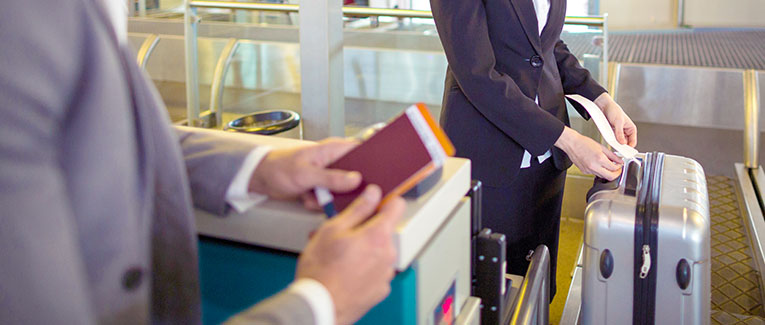
Knowing the steps for departing the U.S. before you get to the airport will help to calm your nerves.
For example, previously, the paper version of Form I-94 was required for departing the U.S. However, it has been eliminated effective May 2013. U.S. Customs and Border Protection (CBP) will record your departure electronically via manifest information provided by the carrier or by CBP. Therefore, no action is required from you regarding Form I-94.
Now that you know this tidbit of info, your preparatory step decreases by 1. Here’s what to do when departing the U.S.
Step 1 for departing the U.S. – Checking-in at the airport
When you reach the airport, proceed to the departure area, which may be on a different floor than the arrival area. Unload your bags from the car. There are helpers to take your bags to the airline counter. If you use them, you should tip them. Otherwise, you can rent a trolley (usually $5/trolley) and load all the bags onto that.
Proceed to the airline counter. There are various lines for different classes of passengers, such as first-class, business class, and economy class. Depending upon your frequent flyer miles status, you may be able to use the premium class line, even if you are traveling in economy class.
Show your passport to the attendant at the counter. They will check that you are eligible to fly to your destination. If you are going back to your country of citizenship, you are obviously eligible to travel there. However, depending upon the airline and your visa status in the U.S., you may be required to get a transit visa for a layover where you would change planes to a connecting flight, even if you are not leaving the airport.
Checking in when departing the U.S. may take a long time. This is because the agents want to be sure you’re not carrying something you shouldn’t. That’s why it’s recommended you reach the airport 4 hours before your flight time.
The airline attendant will ask you to place your checked bags on the weighing machine one by one. If the bags are within the weight limit, they will attach a tag for your final destination. Otherwise, they will ask you to remove some of the belongings or put them into another bag, if it has a lower weight.
You will be issued one or more boarding passes to your final destination, usually for all the legs that are part of your ticket.
No tags are required for carry-on luggage, though it may be helpful to have a tag in case you were to misplace or lose your carry-on during your journey.
Step 2 for departing the U.S. – Security check
Once you have your boarding pass, you will proceed to the security lines. Depending upon your class of travel, there may be different lines. Security checks in the U.S. are thorough, so be prepared for that. The officer will check your boarding pass and passport. You will have to put your carry-on luggage through an X-ray scanning machine. Even if you have TSA Pre-Check status for domestic travel, that usually does not apply for international travel. That means you will have to remove your shoes and jacket. You will have to remove your laptop, tablet, and other larger electronics from your bag and put them in a separate tray. You should remove keys, cell phones, and other items from your pockets and place them in the carry-on bag or tray before they go through the X-ray.
Last step before departure – Getting to your gate and boarding
Once you have cleared that step, you can simply proceed to the gate. The gate may be in the same terminal or a different one. You may be required to take a train, bus, or other means of transportation to get to the correct terminal or gate. Premium-class passengers can wait in their own private lounge.
When it is time to board the plane, the airline staff will call passengers by their group numbers. When it is your turn, you will proceed to board the plane and go to your assigned seat.
Sometimes, before you board the flight, a U.S. customs officer may stop you randomly and ask questions about where you are going, why you are traveling, how much money you are carrying, and so on. Don’t be afraid. Random customs checks in the U.S. are common. You are not being targeted specifically but were randomly selected.
Follow these steps for departing the U.S., then enjoy your flight.

